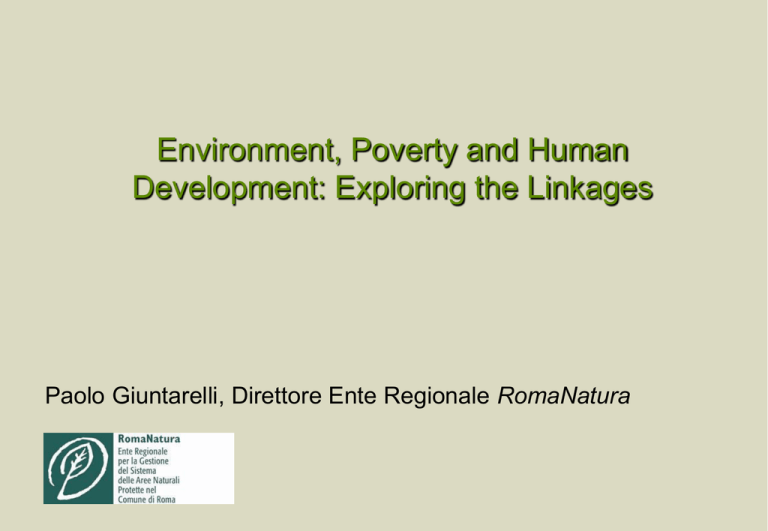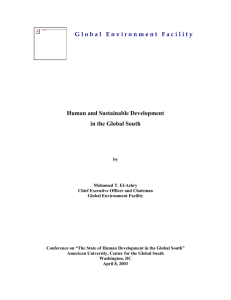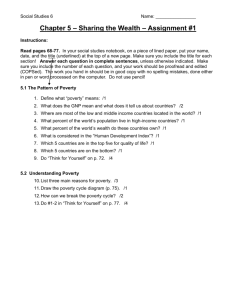MPhil Environment & Development
advertisement

Environment, Poverty and Human Development: Exploring the Linkages Paolo Giuntarelli, Direttore Ente Regionale RomaNatura A Vicious Circle? POVERTY ENVIRONMENTAL DEGRADATION Brundtland Report 1990 - poverty as a major cause and effect of global environmental problems Responding to environmental threats Demand for environmental quality ... Ability to respond to such demands ... … is a luxury - the poor are too busy thinking about basic survival to concern themselves with environmental issues … is dependent on aggregate wealth - economic prosperity and technological sophistication allow nations to react to environmental challenges Ergo ... Environmentalism is the exclusive concern of the rich, in the advanced industrial nations Understanding responses Out of concern for nature To mitigate anthropogenic influences on the natural environment … as a source of cultural, spiritual, social and economic value ... … pollution, resource depletion, extinction of species ... To reduce the impacts of environmental changes on human society … health impacts, livelihoods, needs, wellbeing ... Are these concerns exclusivel y found in rich nations? Views on poverty-environment linkages Conventional wisdom – Deterministic relationship: if one is poor, then one degrades the environment Poverty is negatively related to sustainable development short time horizons of the poor Policy: need for economic growth to break the downward spiral: World Bank WDR 1992 – – Poverty Environmental degradation Alternative perspectives Political economy – Why are people poor? Poor as proximate causes, but (global) inequalities as the ultimate causes Evidence that the poor can and do care for the environment: effective environmental stewardship The poor as environmental activists: new social and ecological movements; grassroots political action Policy - remove inequalities – – – Inequality (power, wealth) Environmental degradation Alternative perspectives Market/institutional failure – Price signals - perverse subsidies/taxes Tenure policies/property rights Legal framework Implementation capacity Competing policy demands Policy – correct market/institutional failure – – – – – Policy imperfections Environmental degradation Alternative perspectives Reversing the causality – Dependence of the poor on natural resources for their livelihoods: CPR studies Impact of internal and external pressures is to undermine the sustainability of the local resource base Policy - improved environmental sustainability as a poverty alleviation strategy – – Poverty Environmental degradation Understanding human well-being Multiple dimensions of well-being – – Physical/financial resources - wealth Human resources - education, health Natural resources - ecosystem services Political resources - democracy, accountability Social/cultural resources - networks, norms, relationships SUSTAINABLE LIVELIHOODS (SL) – – – The SL Framework Livelihood Capital Assets Human Social Physical Vulnerability Context • Shocks • Trends • Seasons Natural Financial Policies & Institutions (Transforming Structures & Processes) • Structures - Government - Private Sector • Processes - Laws - Policies - Culture - Institutions Livelihood Outcomes + Sustainable use of NR base + Income + Well-being Reduced vulnerability + Food security Livelihood Strategies It’s all about pushing out the ‘area’ of these assets Are these assets fungible? Human Capital Social Capital Physical Capital Natural Capital Financial Capital Rural poverty - environment linkages Household objectives: food/livelihood security Available household assets: on-and off-farm physical/financial capital; natural resources; human capital; social capital External factors Household income/investment activities Environmental/economic/social consequences New stock of household assets Ecosystem services Definition – Ecosystem services are the conditions and processes through which natural ecosystems, and the species that make them up, sustain and fulfil human life. Daily et al 1997 * Provisioning functions * Regulating functions * Enriching/cultural functions Ecosystem services: provisioning Magnitude/rate of goods harvested (‘flows’), e.g.: Food Micro-organisms, plant and animal products Genetic material, biochemicals & pharmaceuticals Fuels/energy Fodder Fibre Non-living material Fresh water Ecosystem services: regulating Life support functions, determined by ‘stock’ of the ecosystem, e.g.: Purification of air and water Mitigation of floods and droughts Detoxification and decomposition of wastes Preservation of soil and soil fertility Pollination of crops and vegetation Control of pests Dispersal of seeds Maintenance of biodiversity Stabilisation of climate Ecosystem services: enriching/cultural Beliefs and values surrounding natural forces, providing spiritual/religious/cultural support (determined by ‘stock’), e.g.: Spiritual components Aesthetic values Social relations and values Educational/scientific values Ecosystem services: well-being issues Provisioning: access of the poor for basic needs; distributional issues Regulating: equitable sharing of benefits and costs associated with protection Enriching/cultural: conflicting cognitive paradigms and value/moral systems Potential conflict between these services, but also scope for synergy/win-win scenarios What is Human Development? The basic purpose of development is to enlarge people’s choices. In principle, these choices can be infinite and can change over time. The objective of development is to create an enabling environment for people to enjoy long, healthy and creative lives. HD is not only the rise or fall of national income; It’s about creating an environment in which people can develop their full potential and lead productive, creative lives in accord with their needs and interests. People are the real wealth of nations Fundamental to enlarging the people’s choices is building human capabilities – the range of things that people can do or be in life. Philosophers, economists and political leaders have long emphasized human wellbeing as the purpose, the end, of development. Aristotle said in ancient Greece, “wealth is evidently not the good we are seeking, for it is merely useful for the sake of something else”. The goal is human freedom Human development and human rights are mutually reinforcing, helping to secure the well-being and dignity of all people, building self-respect and the respect of others. Human development report HDR was first launched in 1990 with the single goal of putting people back at the center of the development process in terms of economic debate, policy and advocacy; Since the first report, four new composite indices for HD have been developed – the human development index, the gender empowerment measure, and the human poverty index. The HD report is an indipendent report. It’s commissioned by the United Nations Development Programme. The report is translated into more a dozen language and launched in more than 100 countries annually. Human development index The HDI is a summary measure of three dimensions of human development: leading a long and healthy life, measured by life expetancy at birth, being knowleadgeable, measured by literacy and school enrolment; and having a decent standard of living, measured by GDP per capita (gross domestic product =consumption+investment+exports-imports). Before the HDI itself is calculated, an index need to be created for each of these dimensions





